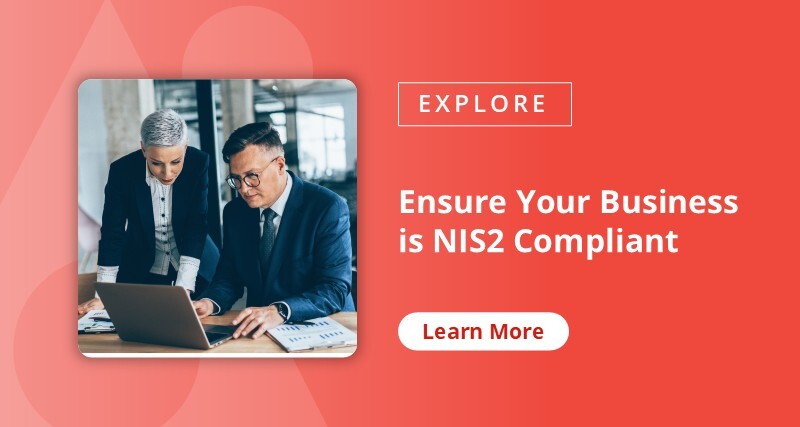NIS2 Compliance: Costly Challenge or Strategic Opportunity?


In an era where cyberthreats are becoming more advanced and pervasive, the European Union has taken a significant step to bolster its cybersecurity framework with the introduction of the Network and Information Systems (NIS2) Directive. Officially referred to as Directive (EU) 2022/2555, NIS2 aims to enhance digital security across Europe by replacing the 2016 NIS Directive and extending its scope to include stricter security measures for what it refers to as “Sectors of High Criticality” and “Other Critical Sectors” (also called essential and important sectors, respectively).
As businesses grapple with the implications of NIS2, a central question emerges: Is compliance merely an added cost, or can it be viewed as a strategic opportunity for growth and competitive advantage? This blog post explores common compliance challenges and how organisations can leverage NIS2 compliance to ensure operational longevity and foster a culture of cybersecurity that enhances customer trust, ultimately positioning them for future success.
Read on to learn how you can make NIS2 compliance a strategic investment and unlock growth opportunities, turning a regulatory requirement into a catalyst for innovation and resilience.
Understanding NIS2 Compliance
NIS2 expands the scope of the original directive to cover organisations in the essential and important sectors. Table 1 shows what industries fall under each category:
| Essential Sectors (Sectors of High Criticality) | Important Sectors (Other Critical Sectors) |
|---|---|
|
|
Table 1. NIS2 categories of in-scope industries
The expansion of NIS2’s scope means more organisations must now comply with stringent cybersecurity standards to create a secure digital environment while harmonising compliance requirements across all EU member states. The four new requirements of NIS2 are:
- Risk Management: Implement comprehensive practices to identify, assess, and mitigate cybersecurity risks.
- Business Continuity: Develop and test business continuity and disaster recovery (BCDR) plans to maintain operations during and after a cyber incident, minimising disruption.
- Reporting Obligations: Report significant cybersecurity incidents to authorities within a specified timeframe to enhance transparency and coordination.
- Corporate Accountability: Ensure senior management is responsible for and oversees cybersecurity measures, with board members adequately trained and informed.
Based on these new requirements, full compliance with NIS2 requires careful planning, consistent executions, and the right resources. We discuss some common challenges to NIS2 compliance in the next section.
Common Challenges to NIS2 Compliance
Ensuring full compliance with NIS2 requires organisations to put their digital data environment in proper order, and this is no easy feat. Here are some of the biggest challenges that enterprises face:
1. Underestimation of the Scope and Scale of Change
Compared to the original directive, the expanded scope and new requirements of NIS2 significantly affects a broader range of organisations. Many businesses underestimate the scale of change required, leading to inadequate planning and resource allocation. Given the scale of NIS2’s impact, one can safely say that many organisations are still unprepared for the compliance demands despite the directive having been enforced since October 2024. This gap is due to the lack of guidance or step-by-step compliance frameworks that consider the nuances in each affected sector, further exacerbating compliance challenges.
2. Resource Allocation
The global cybersecurity skills shortage is a major challenge and leaves a significant impact on the ability of enterprises – both in the EU as well as worldwide – to keep their digital environment secure. In fact, 71% of organisations said they had been negatively affected by the cybersecurity skills shortage according to a 2023 study published by the Information Systems Security Association (ISSA).
Compliance demands substantial investments in hiring skilled personnel, ensuring ongoing training for existing staff, acquiring advanced data security technologies and tools to manage and secure enterprise data. Organisations often struggle with budgeting for these resources, particularly if they have not previously prioritised cybersecurity.
3. Continuous Monitoring and Improvement
NIS2 compliance requires continuous monitoring and adaptation to evolving cyberthreats. Organisations often struggle to establish systems for ongoing assessment and improvement due to the rapidly changing nature of these threats. Regular review and updates of security measures are essential.
Enterprises often struggle with effective continuous monitoring due to limited resources and expertise. The need for real-time threat intelligence and integrating various security tools can overwhelm already stretched teams. Without robust monitoring, organisations risk non-compliance and vulnerabilities that cybercriminals could exploit.
4. Supply Chain Security
The old adage “You are only as strong as your weakest link” has come to the forefront for organisations that now need to truly prioritise third-party risk management. The ransomware attack on the NHS in June 2024, targeting its pathology services provider Synnovis, led to cancelled operations and the postponement of over 3,000 outpatient appointments and 1,200 elective procedures. This disruption underscores the importance of securing supply chains, as emphasised by the directive, which requires organisations to ensure their partners comply with NIS2 standards — a challenging task, especially with third-party vendors lacking robust cybersecurity practices.
A 2023 Gartner report revealed that supply chain attacks are increasing, with 63% of respondents claiming that their organisation has experienced a supply chain attack in the past year. The more vendors an enterprise deals with, the larger the attack surface becomes, so organisations need to carefully consider how to mitigate such risks.
5. Incident Reporting Obligations
NIS2 mandates strict timelines for reporting significant cybersecurity incidents, requiring initial reports within 24 hours and detailed assessments within 72 hours. However, many organisations lack the personnel, budget, and pre-established protocols to handle such time-sensitive mandates effectively. To address such constraints, organisations need a cost-effective and efficient solution to fulfil this vital NIS2 obligation, one that provides immutable audit logs and also integrates directly with security information and event management (SEIM) systems to make reporting across services easier.
We explore how prioritising NIS2 compliance can unlock strategic opportunities for businesses below.
Unlocking the Benefits: Strategic Advantages of NIS2 Compliance
While navigating the complexities of NIS2 compliance may seem daunting, it’s important to recognise the strategic advantages that come with it. By embracing compliance, organisations can not only mitigate risks but also enhance their competitive edge, boost resilience, and achieve significant cost savings. Here’s a closer look at the benefits:
1. Enhanced Data Quality Enables Better Decision-Making
Poor data quality disrupts every GTM motion, from lead generation and sales prospecting to lead nurturing, account prioritisation, and customer growth. Clean, organised data, on the other hand, enables your GTM team to take focused action and pinpoint opportunities. The more complete and accurate the data, the better your marketing and sales efforts align with your target customers’ needs.
NIS2 compliance inevitably enhances data quality, which is crucial for informed decision-making. By implementing stringent data management and security measures for your business-critical data, you can more mindfully cultivate your digital assets and sustainably maintain your data environment. Remember, your AI tools also require quality data to generate the best results, so adhering to the NIS2 requirements is highly beneficial on many fronts.
2. A Strong Data Foundation Bolsters Your Cyber Resilience
A solid compliance framework fortifies your data foundation by ensuring you continuously assess and monitor risks in your digital environment and by putting measures to govern access to your data and systems to prevent any compromise from taking place. Compliance fosters a culture of vigilance and better data security practices among all stakeholders, enabling organisations to operate more effectively while boosting resilience against evolving cyberthreats necessary for thriving in a competitive marketplace.
Moreover, compliance can drive innovation by encouraging the adoption of advanced security technologies and practices, which can lead to improved operational efficiencies. Additionally, demonstrating robust compliance can enhance your organisation’s reputation and build trust with customers and partners, ultimately honing your competitive edge.
3. Enhanced Efficiencies Lead to Cost Savings
While linking cost savings directly to compliance can be challenging, strengthening your data security functions like an insurance policy, significantly reducing the risks of cyberattacks and their potentially catastrophic repercussions on both businesses and their customers.
Investing in NIS2 compliance helps avert costs associated with cyber incidents, such as remediation efforts, ransom payments in some cases, including lost revenues and business opportunities resulting from downtime. Additionally, compliance can enhance an organisation’s ability to quickly adapt to regulatory changes and avoid costly penalties for non-compliance.
Organisations that fail to comply with NIS2 requirements can face fines of up to €10 million or 2% of their global annual revenue, whichever is higher, for essential entities, and up to €7 million or 1.4% of their global annual revenue for important entities.
In summary, NIS2 compliance means more than just meeting regulatory requirements. It’s a strategic move to drive long-term success and sustainability for your organisation.
Simplify NIS2 Compliance with AvePoint
Embedding risk management, least privileged access and business continuity, into the data management process from the outset enables organisations to be more efficient as they navigate the compliance journey with greater confidence. With AvePoint, you can confidently prioritise NIS2 requirements through a comprehensive platform that simplifies the entire compliance process for your peace of mind. The AvePoint Confidence Platform provides centralised visibility, automated policy enforcement, and robust data protection strategies, ensuring your organisation stays secure and compliant so you can focus on thriving.
By adopting security and privacy-by-design principles and automated compliance checks, organisations can minimise regulatory review time and reduce risks. Explore how AvePoint can help now.


Dana Louise Simberkoff is the Chief Risk, Privacy and Information Security Officer at AvePoint. She is responsible for AvePoint’s privacy, data protection, and security programs. She manages a global team of subject matter experts that provide executive level consulting, research, and analytical support on current and upcoming industry trends, technology, standards, best practices, concepts, and solutions for risk management and compliance. Ms. Simberkoff is responsible for maintaining relationships with executive management and multiple constituencies both internal and external to the corporation, providing guidance on product direction, technology enhancements, customer challenges, and market opportunities. Ms. Simberkoff has led speaking sessions at data privacy and security events around the globe. She was featured in Forbes, writes a monthly column for CMSWire, and was highlighted in the CSO Online list of “12 Amazing Women in Security”. She is a current member of the Women Leading Privacy Advisory Board and a past member of the Education Advisory Board for the International Association of Privacy Professionals (IAPP). Ms. Simberkoff holds a BA from Dartmouth College and a JD from Suffolk University Law School. LinkedIn: www.linkedin.com/in/danalouisesimberkoff/en Twitter: http://www.twitter.com/danalouise


